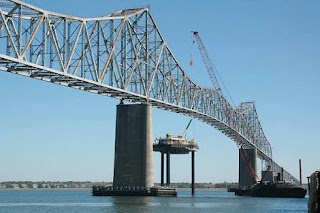Have you ever come across the word “Load”? Do you ever wonder what it means when someone, maybe a lecturer mentions Design load or similar terms such as Live loads, Dead Loads, etc? It is a post about Top 5 Loads in Every Civil Engineering Structure
Well, worry no more because on this post, i am going to explain each one of these loads as it applies to Civil Engineering Structures.
Top 5 Loads In Every Civil Engineering Structure
Here is a list of 5 most common loads that exists in and affects every Civil engineering structure.
1. Live Loads
What Are Live Loads?
A Live load is simply put as those downward forces on a civil engineering structure (could be a building, bridge, etc). live loads are also regarded as moving loads.
In a building, Live loads are best described as comprising of the weight of the occupants, possessions of occupants of a building which may include such things as furniture, electronics, Books, just name whatever has weight in your house.
Live Loads are usually designed for by Civil engineers and are also sppecified on building codes (EG British standard, Euro Code 2, Indian standard, etc).
In a civil engineering language, Live loads are also known as imposed loads.
Minimum Live Load Requirements
Residential Buildings, Live loads = >200 Kg/m2
Offices = 250 Kg/m2
Industrial Buildings, Live Loads = 1000 Kg/m2
2. Dead Loads
What are Dead Loads?
In a civil Engineering term, a dead load is simply a downwards force that acts on a building as a result of the self weight of the building. This self weight is composed of the weights of all structural elements in the building eg facades, walls, roofs, beams, etc.
3. Varying loads
What are Varying Loads?
A Varying or Dynamic load is simply defined as that load created by traffic. It is common with traffic structures such as Bridges and may comprise of braking and acceleration loads
4. Wind Loads
What are Wind Loads?
Wind loads are 4th of the 5 loads that affects civil engineering structures. It is highly considered in High rise buildings like Sky scrappers or buildings with large surface areas.
Now for tall buildings with large surface areas, a wind force of 150 kg/m2 may be specified as this could amount to a great force when factored with the surface area of the tall building
5. Earthquake loads
What are earthquake Loads?
These is a load caused by the horizontal forces on a building. The earthquake exerts this shaking effect on a building and so for this alone, it is required that buildings constructed on earthquake prone areas be designed for higher resistance against the effects of the earthquake.
Well, here are the Top 5 Loads In Every Civil Engineering Structure. I hope you can further look into this as i believe its quite easy to comprehend


